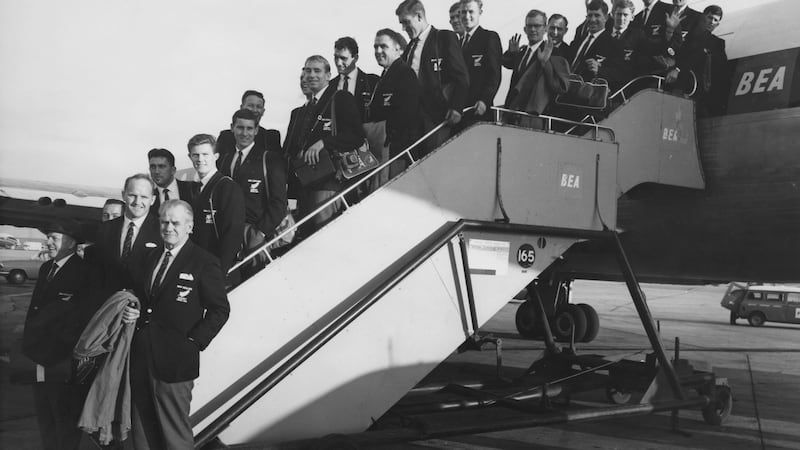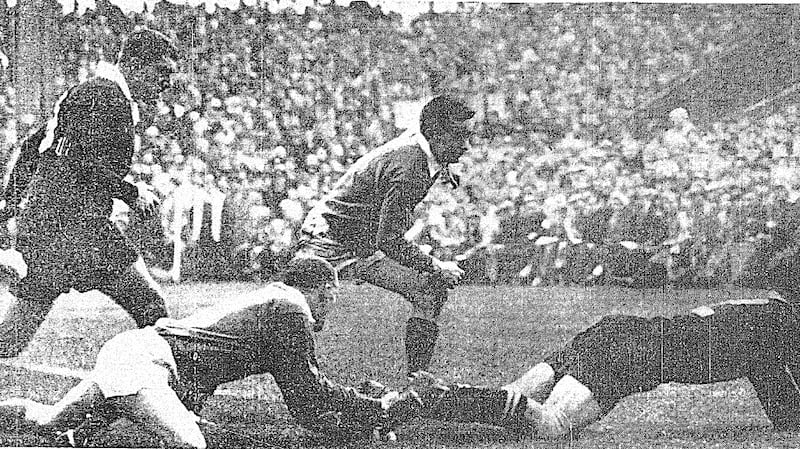Ireland 5 New Zealand 6 – Saturday December 7th 1963
It was the All Blacks first visit to Ireland in 10 years. Nobody gave the hosts a prayer and the might and fearsome reputation of the visitors was magnified in the local imagination of supporters and players alike. “As a young fella, I didn’t know anything about them except that they were supposed to be the best team in the world,” says Alan Duggan, the Lansdowne winger who made his debut that afternoon, aged 19.
Not so much the deep end, then, as dropped into the Atlantic during a storm. On the afternoon of the match, the papers ran breathless pen pictures of rugby names whose faces would be seen for the first time: Colin ‘Pinetree’ Meads, Don ‘the Boot’ Clarke. Bill Mulcahy, Ireland’s lock, had toured New Zealand with the Lions in 1959 and played on the last Lions team to beat the All-Blacks in Eden Park.
Television was a luxury commodity in New Zealand that summer and the complete absorption of the locals in the game stunned him. “It was magical,” he says now. “People would queue overnight not just for the big Test games but for the high profile provincial games too.”
Four years on, the interest in the Dublin was also intense. The visitors had the natural advantage of a touring party, living and training as de facto professionals. They were in the midst of an epic global jaunt which started with a match against the students in Oxford on October 23rd and would conclude with a 39-3 victory over British Columbia in Vancouver. By December, they were in full rugby-mode, in stark contrast to the home side who, as Paul McWeeney detailed in these pages, “leave their offices during the afternoon before the great occasion to snatch an hour or two together and work out their planning.”
Parity in the lineout was central to their ambitions. Mulcahy had noticed something about Meads four years earlier.

“He was big and very strong and he would just pull you across and whip the ball off you if at all possible. In my recollection, you didn’t see him up in the air too often. Willie John (McBride) and I decided to sort of jump into the middle so that you were less easily interfered with than if you took a straight in jump. Your weight was now going towards the opposition and you are less easily knocked out of line. That seemed to work out okay for us. We hustled them a lot around the park. We got into a groove and got them unsettled and kept them unsettled.”
In fact, Ireland defied every expectation. Terence de Vere White was among the crowd and felt tentative as he watched “our 15 selected victims run onto the field for sacrifice”, glumly weighing up the Irish chances: “Six stone lighter in the pack, outpaced in the backs: what chance had they?”
Every, it turned out. John Fortune, late of Clontarf RFC, scored the first try of the game. In the few minutes of game footage that exist, you see the crowd almost flush against the touch line. “I remember once or twice ending up in someone’s arms. That happened a few times,” says Duggan. “That’s the way it was then. The crowd were right on top of the teams. It was a good feeling.”
The debutante’s nerves evaporated after a few minutes: it became another rugby game. At one stage, the ball was kicked ahead and Duggan saw his chance to nail Clarke, New Zealand’s feted full back. “I was saying: ‘I’m going to hammer this guy’. So I dived at him. And I just bounced off him. Didn’t know what hit me.”
Ireland’s converted try saw them lead 5-3 (Kel Tremain had scored a try for the visitors) in the closing quarter when the match turned in controversy. Pat Casey, the UCD centre, broke towards the Old Wanderers corner and put in a high cross field kick. Eamon Maguire, the UCG flanker, reacted first. “Eamon, God rest him, was very fast out of the traps,” says Mulcahy. “He tore up and jumped in the air, caught it Gaelic fashion, if you like. I think the referee probably decided he couldn’t possibly be onside because he was so fast out of the traps.”
The Irish players were incandescent at the offside call which ruled out a try. “We were going nuts,” says Duggan. “There was no doubt but it was a score. The referee . . . was he Welsh?”

In fact, he was a Mr H Keenan from England and he was not for turning. In the last minutes, Wilson Whineray grabbed a word with Ireland’s captain, Ronnie Dawson, that the score should have been good. By then, Clarke had kicked a late penalty from a minor scrum infringement to push them into the narrowest of leads. “They could afford to be charitable,” says Mulcahy.
In the seasons afterwards, Mulcahy and Maguire used to talk about the try. It was one of those what-if moments that would be soon forgotten about by all but the participants. “We were adamant that it was a good score.” The Kiwis moved on, beating England, Wales and France and engaging Scotland in a bizarre 0-0 draw.
In all, they played 36, won 34 that winter. Their sole loss was against Newport: 0-3. Alan Duggan was capped 25 times for Ireland, scoring 11 tries but he never got another crack at New Zealand. It took a few years before the group realised that they had been on the threshold of something historic that afternoon. It wasn’t New Zealand’s blinding brilliance or physical prowess that had won the day so much as the sense that because it was New Zealand, they would find a way. “I think it was that mystique they always had,” says Duggan of what made them so difficult to beat. “They were the All Blacks.”
Ireland: T.J. Kiernan; J Fortune, P Casey, J Walsh A Duggan: M English, J Kelly; P.J. Dwyer, A.R. Dawson, R McLaughlin; W.J. McBride, W.A. Mulcahy; E Maguire, N Murphy; P.J.A. O'Sullivan.
New Zealand: D.B. Clarke; MJ Dick, D.A Arnold, P.F Little, R.W. Caulton; M.A Herewini, K.C Briscoe; K.F Gray, D Young, W J Whineray; A.J Stewart, C.E Meads; K.R Tremain, DJ Graham; S Meads.











